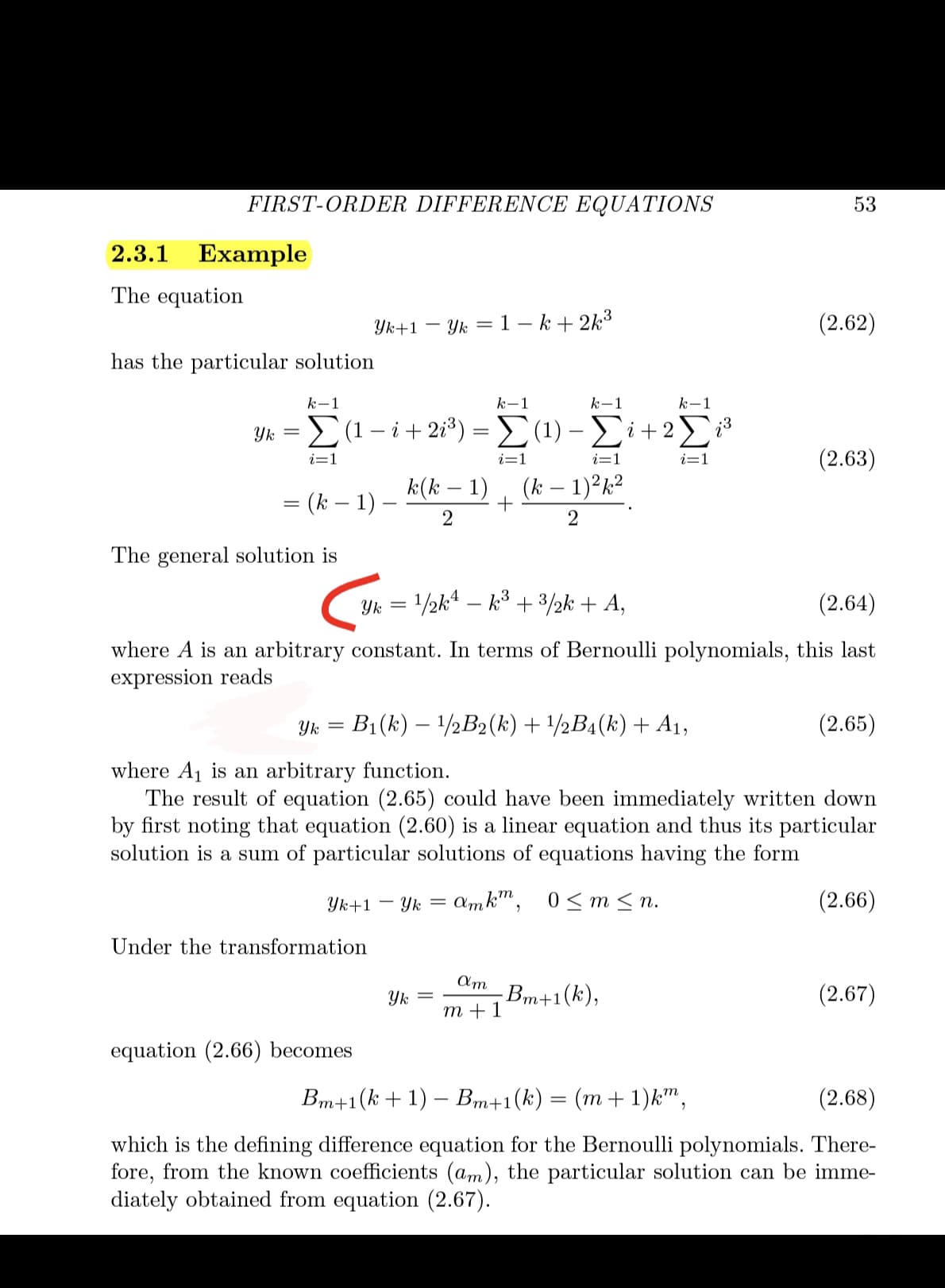FIRST-ORDER DIFFERENCE EQUATIONS 53 2.3.1 Example The equation Yk+1 – Yk = 1 – k+ 2k³ (2.62) has the particular solution k-1 k-1 k-1 k-1 Σ(1-i+23) Σ(1) -Σ i+2i %3| i=1 i=1 i=1 (2.63) i=1 k(k – 1) (k – 1)²k² = (k – 1) - 2 The general solution is Yk = 1/2k* – k° + 3/2k + A, (2.64) where A is an arbitrary constant. In terms of Bernoulli polynomials, this last expression reads
FIRST-ORDER DIFFERENCE EQUATIONS 53 2.3.1 Example The equation Yk+1 – Yk = 1 – k+ 2k³ (2.62) has the particular solution k-1 k-1 k-1 k-1 Σ(1-i+23) Σ(1) -Σ i+2i %3| i=1 i=1 i=1 (2.63) i=1 k(k – 1) (k – 1)²k² = (k – 1) - 2 The general solution is Yk = 1/2k* – k° + 3/2k + A, (2.64) where A is an arbitrary constant. In terms of Bernoulli polynomials, this last expression reads
Algebra & Trigonometry with Analytic Geometry
13th Edition
ISBN:9781133382119
Author:Swokowski
Publisher:Swokowski
Chapter5: Inverse, Exponential, And Logarithmic Functions
Section5.6: Exponential And Logarithmic Equations
Problem 3E
Related questions
Concept explainers
Equations and Inequations
Equations and inequalities describe the relationship between two mathematical expressions.
Linear Functions
A linear function can just be a constant, or it can be the constant multiplied with the variable like x or y. If the variables are of the form, x2, x1/2 or y2 it is not linear. The exponent over the variables should always be 1.
Question
100%
Explain the determaine step by step how he was solved the general solution

Transcribed Image Text:FIRST-ORDER DIFFERENCE EQUATIONS
53
2.3.1
Example
The equation
Yk+1 – Yk = 1 – k + 2k3
(2.62)
has the particular solution
k-1
k-1
k-1
k-1
Yk =E(1- i+ 2i*) = (1) –i+2
i=1
i=:
(2.63)
i=1
i=1
k(k – 1)
(k – 1)²k?
= (k – 1)
2
The general solution is
Yk = /2k* – k° + 3/½k + A,
(2.64)
where A is an arbitrary constant. In terms of Bernoulli polynomials, this last
expression reads
Yk = B1(k) – 1/2B2(k)+1/½B4(k) + A1,
(2.65)
where A1 is an arbitrary function.
The result of equation (2.65) could have been immediately written down
by first noting that equation (2.60) is a linear equation and thus its particular
solution is a sum of particular solutions of equations having the form
Yk+1 – Yk =
amk", 0< m< n.
(2.66)
Under the transformation
Am
Вт+1(k),
m +1
(2.67)
Yk
equation (2.66) becomes
Bm+1(k +1) – Bm+1(k)
(m + 1)k",
(2.68)
which is the defining difference equation for the Bernoulli polynomials. There-
fore, from the known coefficients (am), the particular solution can be imme-
diately obtained from equation (2.67).
Expert Solution
This question has been solved!
Explore an expertly crafted, step-by-step solution for a thorough understanding of key concepts.
Step by step
Solved in 2 steps with 2 images

Knowledge Booster
Learn more about
Need a deep-dive on the concept behind this application? Look no further. Learn more about this topic, advanced-math and related others by exploring similar questions and additional content below.Recommended textbooks for you

Algebra & Trigonometry with Analytic Geometry
Algebra
ISBN:
9781133382119
Author:
Swokowski
Publisher:
Cengage

Algebra & Trigonometry with Analytic Geometry
Algebra
ISBN:
9781133382119
Author:
Swokowski
Publisher:
Cengage